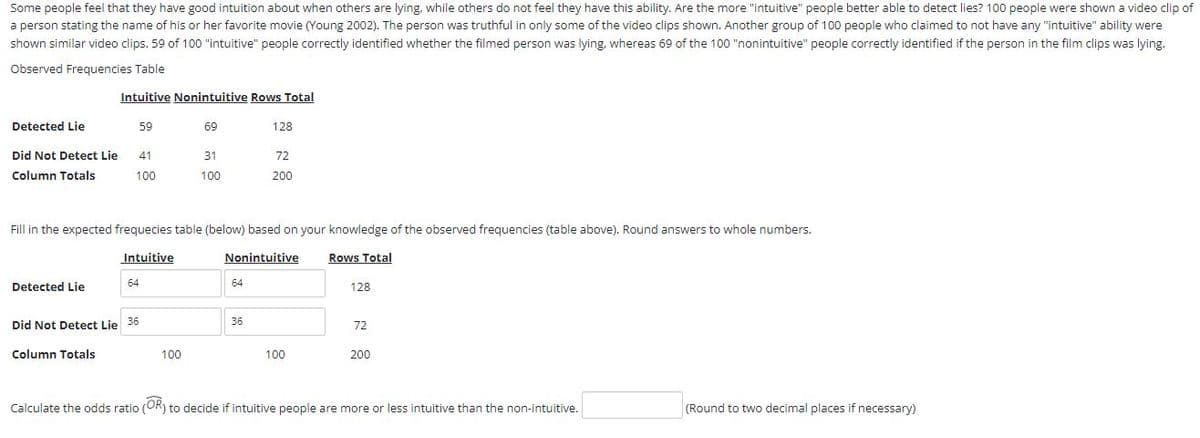Some people feel that they have good intuition about when others are lying, while others do not feel they have this ability. Are the more "intuitive" people better able to detect lies? 100 people were shown a video clip of a person stating the name of his or her favorite movie (Young 2002). The person was truthful in only some of the video clips shown. Another group of 100 people who claimed to not have any "intuitive" ability were shown similar video clips. 59 of 100 "intuitive" people correctly identified whether the filmed person was lying, whereas 69 of the 100 "nonintuitive" people correctly identified if the person in the film clips was lying. Observed Frequencies Table Intuitive Nonintuitive Rows Total Detected Lie Did Not Detect Lie Column Totals 59 Detected Lie 41 100 64 Did Not Detect Lie 36 Column Totals 69 Fill in the expected frequecies table (below) based on your knowledge of the observed frequencies (table above). Round answers to whole numbers. Intuitive Nonintuitive Rows Total 100 31 100 64 128 36 72 200 100 128 72 200 Calculate the odds ratio (OR) to decide if intuitive people are more or less intuitive than the non-intuitive. (Round to two decimal places if necessary)
Some people feel that they have good intuition about when others are lying, while others do not feel they have this ability. Are the more "intuitive" people better able to detect lies? 100 people were shown a video clip of a person stating the name of his or her favorite movie (Young 2002). The person was truthful in only some of the video clips shown. Another group of 100 people who claimed to not have any "intuitive" ability were shown similar video clips. 59 of 100 "intuitive" people correctly identified whether the filmed person was lying, whereas 69 of the 100 "nonintuitive" people correctly identified if the person in the film clips was lying. Observed Frequencies Table Intuitive Nonintuitive Rows Total Detected Lie Did Not Detect Lie Column Totals 59 Detected Lie 41 100 64 Did Not Detect Lie 36 Column Totals 69 Fill in the expected frequecies table (below) based on your knowledge of the observed frequencies (table above). Round answers to whole numbers. Intuitive Nonintuitive Rows Total 100 31 100 64 128 36 72 200 100 128 72 200 Calculate the odds ratio (OR) to decide if intuitive people are more or less intuitive than the non-intuitive. (Round to two decimal places if necessary)
MATLAB: An Introduction with Applications
6th Edition
ISBN:9781119256830
Author:Amos Gilat
Publisher:Amos Gilat
Chapter1: Starting With Matlab
Section: Chapter Questions
Problem 1P
Related questions
Question
could you explain how to calculate the odds ratio?

Transcribed Image Text:Some people feel that they have good intuition about when others are lying, while others do not feel they have this ability. Are the more "intuitive" people better able to detect lies? 100 people were shown a video clip of
a person stating the name of his or her favorite movie (Young 2002). The person was truthful in only some of the video clips shown. Another group of 100 people who claimed to not have any "intuitive" ability were
shown similar video clips. 59 of 100 "intuitive" people correctly identified whether the filmed person was lying, whereas 69 of the 100 "nonintuitive" people correctly identified if the person in the film clips was lying.
Observed Frequencies Table
Intuitive Nonintuitive Rows Total
Detected Lie
Did Not Detect Lie
Column Totals
59
Detected Lie
41
100
64
Did Not Detect Lie 36
Column Totals
69
Fill in the expected frequecies table (below) based on your knowledge of the observed frequencies (table above). Round answers to whole numbers.
Intuitive
Nonintuitive
Rows Total
100
31
100
64
128
36
72
200
100
128
72
200
Calculate the odds ratio (OR) to decide if intuitive people are more or less intuitive than the non-intuitive.
(Round to two decimal places if necessary)
Expert Solution
This question has been solved!
Explore an expertly crafted, step-by-step solution for a thorough understanding of key concepts.
This is a popular solution!
Trending now
This is a popular solution!
Step by step
Solved in 2 steps

Recommended textbooks for you

MATLAB: An Introduction with Applications
Statistics
ISBN:
9781119256830
Author:
Amos Gilat
Publisher:
John Wiley & Sons Inc

Probability and Statistics for Engineering and th…
Statistics
ISBN:
9781305251809
Author:
Jay L. Devore
Publisher:
Cengage Learning

Statistics for The Behavioral Sciences (MindTap C…
Statistics
ISBN:
9781305504912
Author:
Frederick J Gravetter, Larry B. Wallnau
Publisher:
Cengage Learning

MATLAB: An Introduction with Applications
Statistics
ISBN:
9781119256830
Author:
Amos Gilat
Publisher:
John Wiley & Sons Inc

Probability and Statistics for Engineering and th…
Statistics
ISBN:
9781305251809
Author:
Jay L. Devore
Publisher:
Cengage Learning

Statistics for The Behavioral Sciences (MindTap C…
Statistics
ISBN:
9781305504912
Author:
Frederick J Gravetter, Larry B. Wallnau
Publisher:
Cengage Learning

Elementary Statistics: Picturing the World (7th E…
Statistics
ISBN:
9780134683416
Author:
Ron Larson, Betsy Farber
Publisher:
PEARSON

The Basic Practice of Statistics
Statistics
ISBN:
9781319042578
Author:
David S. Moore, William I. Notz, Michael A. Fligner
Publisher:
W. H. Freeman

Introduction to the Practice of Statistics
Statistics
ISBN:
9781319013387
Author:
David S. Moore, George P. McCabe, Bruce A. Craig
Publisher:
W. H. Freeman